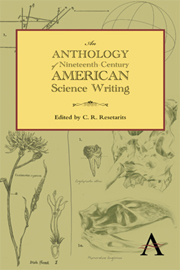Book contents
- Frontmatter
- Contents
- Preface
- Part One 1800–1846 Naturals and Naturalists
- Part One Introduction
- “A Memoir on the Discovery of Certain Bones of a Quadruped of the Clawed Kind in the Western Parts of Virginia,” Transactions of the American Philosophical Society (1799)
- “Pileated Woodpecker,” American Ornithology; or the Natural History of the Birds of the United States (1801)
- “Currents,” The New American Practical Navigator (1802)
- “Account of a North American Quadruped, supposed to belong to the Genus Ovis, Rocky-Mountain Sheep, Ovis Montana,” Journal of the Academy of Natural Sciences of Philadelphia (1817)
- “A Monograph of North American insects, of the genus Cincindela” (excerpt) Transactions of the American Philosophical Society (1818)
- “On the Genus Ocythoe,” Philosophical Transactions of the Royal Society of London (1819)
- “Preface,” American Entomology, or Descriptions of the Insects of North America (1824–28)
- “Preface” (excerpt), The Genera of North American Plants and a Catalogue of the Species, to the Year 1817 (1818)
- “Pileated Woodpecker,” Manual of the Ornithology of the United States and Canada (1832)
- “Introduction,” Ichthyologia ohiensis, or natural history of the fishes inhabiting the river Ohio and its tributary streams (1820)
- “Notices of Materia Medica, or new medical properties of some American Plants,” Western Minerva or, American Annals of Knowledge and Literature (1820)
- “Passenger Pigeon,” Ornithological Biography (1831)
- “On the Production of Currents and Sparks of Electricity from Magnetism,” American Journal of Science and Arts (July 1832)
- “The Contagiousness of Puerperal Fever” (excerpts), New England Quarterly Journal of Medicine (1843)
- “On the Two Storms Which Were Experienced throughout the United States, in the Month of February, 1842” (excerpt) Transactions of the American Philosophical Society (1845)
- Part Two 1846–1876 Warriors
- Part Three 1876–1900 Scientists
- Bibliography
“Passenger Pigeon,” Ornithological Biography (1831)
from Part One - 1800–1846 Naturals and Naturalists
Published online by Cambridge University Press: 05 June 2012
- Frontmatter
- Contents
- Preface
- Part One 1800–1846 Naturals and Naturalists
- Part One Introduction
- “A Memoir on the Discovery of Certain Bones of a Quadruped of the Clawed Kind in the Western Parts of Virginia,” Transactions of the American Philosophical Society (1799)
- “Pileated Woodpecker,” American Ornithology; or the Natural History of the Birds of the United States (1801)
- “Currents,” The New American Practical Navigator (1802)
- “Account of a North American Quadruped, supposed to belong to the Genus Ovis, Rocky-Mountain Sheep, Ovis Montana,” Journal of the Academy of Natural Sciences of Philadelphia (1817)
- “A Monograph of North American insects, of the genus Cincindela” (excerpt) Transactions of the American Philosophical Society (1818)
- “On the Genus Ocythoe,” Philosophical Transactions of the Royal Society of London (1819)
- “Preface,” American Entomology, or Descriptions of the Insects of North America (1824–28)
- “Preface” (excerpt), The Genera of North American Plants and a Catalogue of the Species, to the Year 1817 (1818)
- “Pileated Woodpecker,” Manual of the Ornithology of the United States and Canada (1832)
- “Introduction,” Ichthyologia ohiensis, or natural history of the fishes inhabiting the river Ohio and its tributary streams (1820)
- “Notices of Materia Medica, or new medical properties of some American Plants,” Western Minerva or, American Annals of Knowledge and Literature (1820)
- “Passenger Pigeon,” Ornithological Biography (1831)
- “On the Production of Currents and Sparks of Electricity from Magnetism,” American Journal of Science and Arts (July 1832)
- “The Contagiousness of Puerperal Fever” (excerpts), New England Quarterly Journal of Medicine (1843)
- “On the Two Storms Which Were Experienced throughout the United States, in the Month of February, 1842” (excerpt) Transactions of the American Philosophical Society (1845)
- Part Two 1846–1876 Warriors
- Part Three 1876–1900 Scientists
- Bibliography
Summary
The Passenger Pigeon, or, as it is usually named in America, the Wild Pigeon, moves with extreme rapidity, propelling itself by quickly repeated flaps of the wings, which it brings more or less near to the body, according to the degree of velocity which is required. Like the Domestic Pigeon, it often flies, during the love season, in a circling manner, supporting itself with both wings angularly elevated, in which position it keeps them until it is about to alight. Now and then, during these circular flights, the tips of the primary quills of each wing are made to strike against each other, producing a smart rap, which may be heard at a distance of thirty or forty yards. Before alighting, the Wild Pigeon, like the Carolina Parrot and a few other species of birds, breaks the force of its flight by repeated flappings, as if apprehensive of receiving injury from coming too suddenly into contact with the branch or the spot of ground on which it intends to settle.
I have commenced my description of this species with the above account of its flight, because the most important facts connected with its habits relate to it migrations. These are entirely owing to the necessity of procuring food, and are not performed with the view of escaping the severity of a northern latitude, or of seeking a southern one for the purpose of breeding.
- Type
- Chapter
- Information
- Publisher: Anthem PressPrint publication year: 2012



